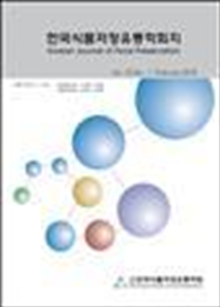간행물
한국식품저장유통학회지 (Korean J. Food Preserv.) KCI 등재 SCOPUS 한국식품저장유통학회지 The Journal of Korean Society of Food Preservation

- 발행기관 한국식품저장유통학회
- 자료유형 학술지
- 간기 연7회
- ISSN 1738-7248 (Print)2287-7428 (Online)
- 수록기간 1994 ~ 2018
- 주제분류 농수해양 > 식품과학 농수해양 분류의 다른 간행물
- 십진분류KDC 521DDC 630
권호리스트/논문검색
제6권 제1호 (1999년 3월) 22건
21.
1999.03
서비스 종료(열람 제한)
This study was carried out to investigate the effect of Pine needle extract on lipid oxidation and free radical reaction in iron sources reacted with active oxygen species. The results were summarized as follow; The pine needle extracts didn`t show a distinct effect on reduction of lipid oxidation if the iron ion didn`t exist in oil emulsion. The pine needle extracts played role as a strong chelating agents to bind iron ion if Ferrous iron(Fe\ulcorner) exist in oil emulsion. Ferric iron(Fe) was lower effect than Ferrous iron(Fe) on free radical reaction in oil emulsion. And also, the Fe\ulcorner reacted with pine needle extract did not show distinct effect on free radical reaction, compared to Fe\ulcorner reacted with pine needle extract. And also, Pine needle extracts reacted with H\ulcornerO\ulcorner were tended to show a low oxygen scavenging ability in case of H\ulcornerO\ulcorner only was existed, compared to those of H\ulcornerO\ulcorner + Fe\ulcorner complex. Pine needle extracts were the most powerful Fe\ulcorner binding agents, compared to other strong synthetic antioxidants such as EDTA and DTPA.
22.
1999.03
서비스 종료(열람 제한)
Effective synthetic antioxidants such as butylated hydroxyanisole(BHA) and butylated hydroxytoluene(BHT) have been widely used in the food industry, but they are suspected to be toxic and carcinogenic effects. Therefore, the development of safely available natural antioxidants such as ascorbic acid, -tocopherol, -carotene, flavonoids and selenium is essential. In particular, flavonoids, 2-phenyl-benzo--pyrones, are polyphenolic compounds that occur ubiquitously in food of plant origin. flavonoids occur in foods generally as O-glycosides with sugars bound usually at the C\ulcorner position. And variations in their heterocyclic ring gibes rise to flavones, flavonols, flavanones, flavanols, catechins, anthocyanidins, chalcone and isoflavones. Vegetables, fruits, and beverages are the main dietary sources of the flavonols, primarily as quercetin, kaempferol, and myricetin and the corresponding flavones, apigenin and luteolin. These flavonoids have biological activity such as antioxidant, anti-inflammatory, antithrombotic, antimutagenic, anticarcimogenic antiallergic and antimicrobial activity effects in vitro and in vivo. Flavonoids posses strong antioxidant activities acting as oxygen radicals scavenger, metal chelators and enzyme inhibitor. The antioxidant activity of flavonoids is determined by their molecular structure and more specially, by the position and degree of hydroxylation of the ring structure. All flavonoids with the 3`, 4`-dihydroxy(ortho-dihydroxy) posses marked antioxidant activity. And antioxidant activity increases with the number of hydroxyl groups substituted on the A-and B-rings. There is as yet no certainty about the effect of the presence of a double bond between C\ulcorner and C\ulcorner on the antioxidant activity of flavonoids.
1
2

